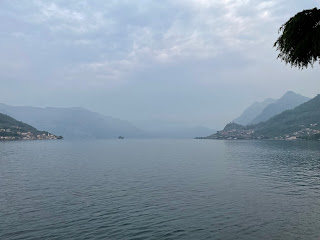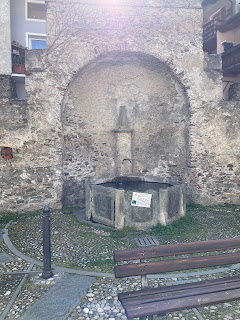Our day began with a walking tour of Trento led by our local guide, Martin Rossi. He made a point of introducing himself as a true son of Trento, with a typically Italian last name and a completely germanic first name. It was his illustration of Trento (or Trent) as a borderland with 1000 years of heritage as part of Austria, followed by the last 100+ years of being an Italian city. That was the theme of the tour.
Trento was long ruled by a series of prince-bishops, who derived power both from the Pope and from the Holy Roman Emperor. This dual, ecclesiastical and political rule gave it special status. Trento continues to be one of a handful of "autonomous" provinces of Italy, with special exemptions from Italian national policies and taxes. Its proximity to the border has also provided advantages as a place "in between."
One symbol of Trento's strategic importance is the presence here of a large palace built by Jakob Fugger, the patriarch of the famous banking family that supplanted the Medicci. Fugger is considered to be one of the richest persons of all time, and was well known as Jakob Fugger, "The Rich." At its peak, his wealth is estimated to have been 2% of Europe's entire GDP at the time. His little cottage here, far away from the family home in Augsburg, Germany, had "only" about 20 bedrooms(!).
It's no accident that the famous Council of Trent, that formulated the post-Reformation Roman Catholic Church, took place here -- in a place "in between" where Popes and Emperors shared power and bankers pulled strings quietly in the background.
Trento was strategic in the late Middle Ages and Early Modern period, but not so much during the World Wars of the 20th century. Good for Trento! The lack of strategic importance meant very little bombing or battle damage. Thus, the city remains a treasure trove of buildings dating back to the 13th century and after. The city's current prosperity means that all of them are clean, restored, and beautiful.
There are beautiful frescos everywhere: In the duomo, on the sides of commercial buildings, on ancient palaces, etc. Although there has been some restoration, most are the real deal.
When we checked into the hotel yesterday we were given "Trentino Cards," a tourist discount card that I'm sure we paid for as part of our tour. At the conclusion of the walking tour, using the cards, we rode on a cable car to the top of a mountain for a view of the city.
The city is very compact and walkable, so from the cable car we strolled through a nice park, then back to our hotel for a potty break.
Then we were off to the castle of the prince-bishops -- a monstrosity begun in the 10th century and then added onto over and over again. Our expectations were low, but the museum exhibits were much better than we anticipated, and the collection was much more extensive.
The theme, like that of our tour, was of Trento as an "in between" place. It was demonstrated in architecture, artifacts, and artwork spanning the pre-Roman period up through the First World War. We spent more time there than we had planned.
After a snack in the castle gardens, we returned to the city center, taking a peek into the church of St. Pietro (Peter) that had some lovely stained glass windows.
We visited an underground exhibit of a Roman street, with emphasis on the 2000 year old water and sewage systems. This exhibit was also much more extensive and better presented than we had expected.
When we presented our Trentino Cards at a museum adjacent to the duomo, a woman who spoke no English essentially kidnapped us and hauled us next door to see the crypt of the duomo. Again, our cards got us in free. And again, it was more than we expected, seeing foundations of an 1600 year-old basilica over which the current church is built.
We returned to the museum we had started to go to, but by that time we were beginning to feel a bit of fatigue, so we gave the first of three floors a once-over, and called it good. We relaxed back at the hotel with the rest of a bottle of wine we had purchased the previous day.
In the evening, our group reconvened at the hotel to walk to a restaurant for an included dinner.


















































